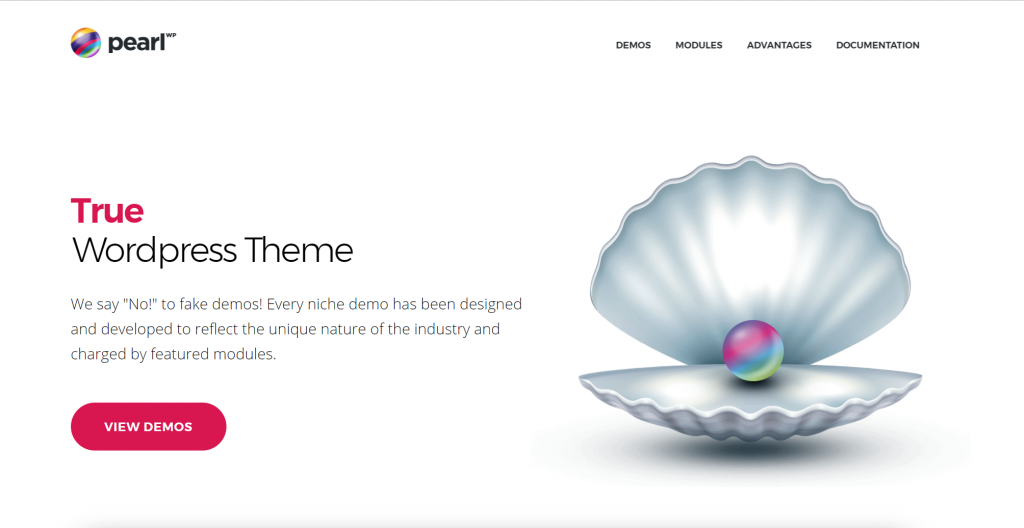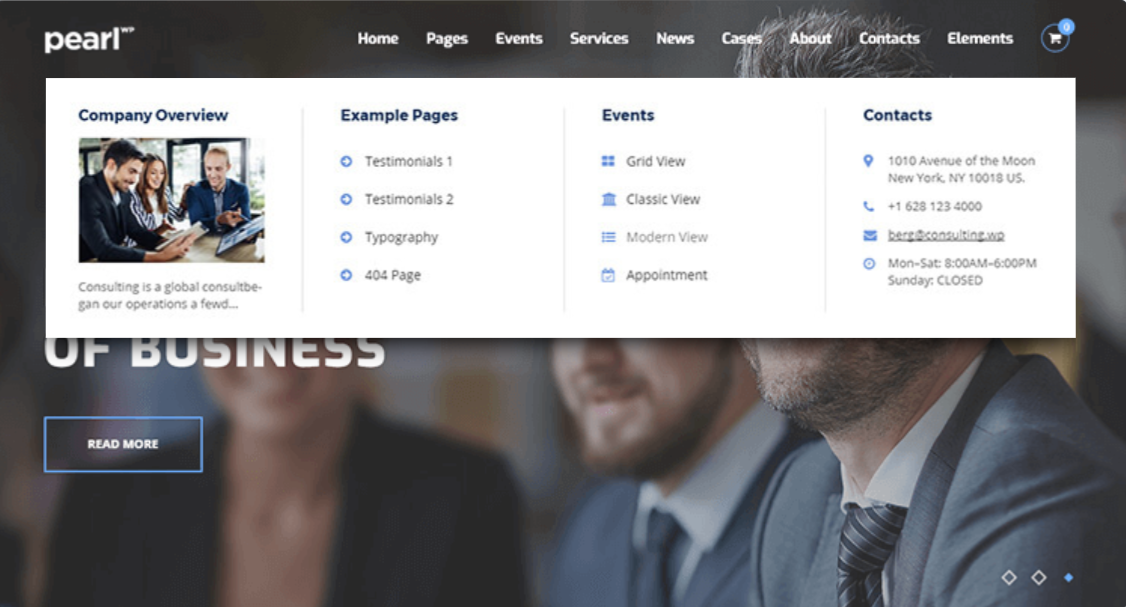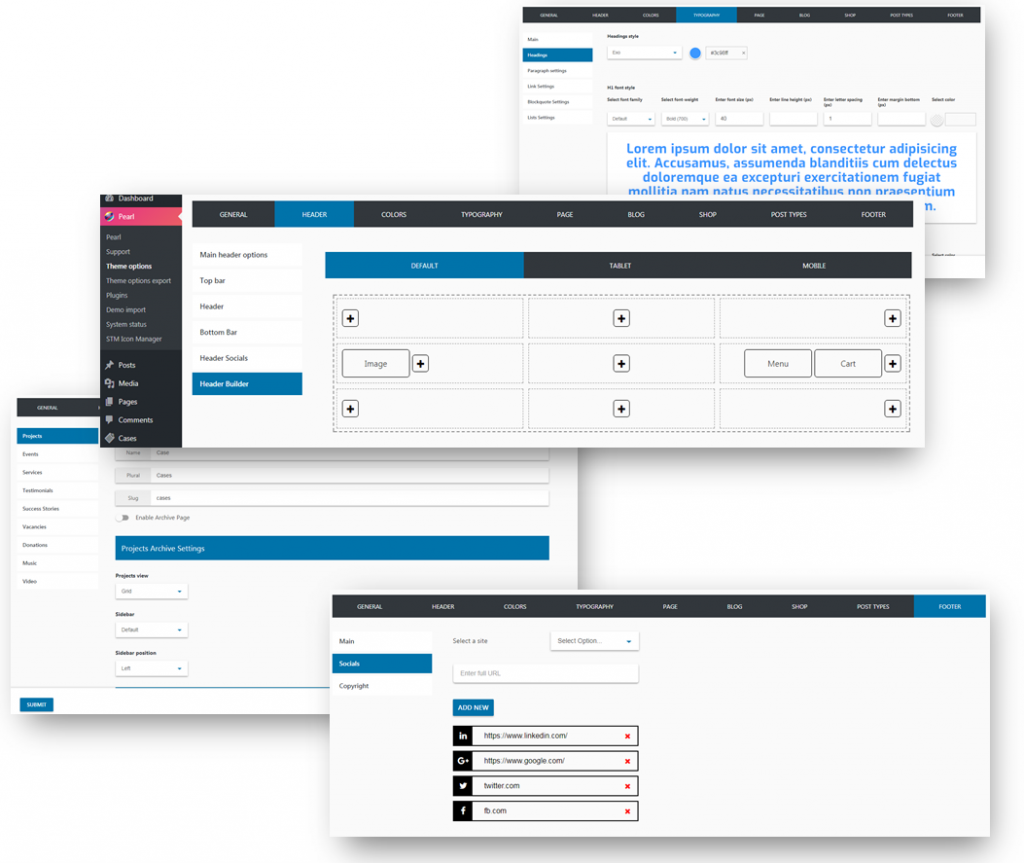Pearl: The Premium WordPress Theme With the 200+ Faces

If a premium WordPress theme suits all of your customers, yet no design looks like the other, you might be using Pearl. Let's take a more in-depth look at it.
 Pearl: Landing Page (Screenshot: Noupe)[/caption]
In all other cases, which would be about 99 percent, you'll fall back on a theme or a theme framework, if the goal is WordPress as a CMS. The client cares about the visuals and features. He won't build a shrine for you if you create a unicum.
Pearl: Landing Page (Screenshot: Noupe)[/caption]
In all other cases, which would be about 99 percent, you'll fall back on a theme or a theme framework, if the goal is WordPress as a CMS. The client cares about the visuals and features. He won't build a shrine for you if you create a unicum.
 This is what a typical company website made with Pearl could look like. But it it could look completely different as well. (Screenshot: Stylemix)[/caption]
Pearl covers a lot of the functionality via popular premium plugins. The required licenses are included and don't need to be bought separately. Stylemix also provides specific Pearl plugins for some features. For example, you'll find the Header Builder, which is based on Angular.js, allowing you to create a website header that deserves its name. The same applies for the Pearl Mega Menu Builder, which lets you create flexible menu structures within your navigation. Amazon sends its regards.
[caption id="attachment_103183" align="aligncenter" width="1126"]
This is what a typical company website made with Pearl could look like. But it it could look completely different as well. (Screenshot: Stylemix)[/caption]
Pearl covers a lot of the functionality via popular premium plugins. The required licenses are included and don't need to be bought separately. Stylemix also provides specific Pearl plugins for some features. For example, you'll find the Header Builder, which is based on Angular.js, allowing you to create a website header that deserves its name. The same applies for the Pearl Mega Menu Builder, which lets you create flexible menu structures within your navigation. Amazon sends its regards.
[caption id="attachment_103183" align="aligncenter" width="1126"] Example of a Navigation Menu Made Using the Pearl Mega Menu Builder. (Screenshot: Noupe)[/caption]
By the way, the developers also made sure that Pearl is compatible with as many plugins as possible. With other theme creators, you might run into some unpleasant surprises in that regard. I can remember dozens of cases where a plugin installation or a simple update caused a website to blackout entirely.
Aside from the variety of design- and function-related options, the fact that Pearl is capable of making all adjustments, either visually or in a dialogue, deserves a special mention. Manually interfering with files, like writing or rewriting code, is fully redundant. Thus, Pearl is not only interesting for creative workers but also an alternative for the ambitioned DIY'er who wants to build his website by himself despite all the tedious detail work.
[caption id="attachment_103180" align="aligncenter" width="1024"]
Example of a Navigation Menu Made Using the Pearl Mega Menu Builder. (Screenshot: Noupe)[/caption]
By the way, the developers also made sure that Pearl is compatible with as many plugins as possible. With other theme creators, you might run into some unpleasant surprises in that regard. I can remember dozens of cases where a plugin installation or a simple update caused a website to blackout entirely.
Aside from the variety of design- and function-related options, the fact that Pearl is capable of making all adjustments, either visually or in a dialogue, deserves a special mention. Manually interfering with files, like writing or rewriting code, is fully redundant. Thus, Pearl is not only interesting for creative workers but also an alternative for the ambitioned DIY'er who wants to build his website by himself despite all the tedious detail work.
[caption id="attachment_103180" align="aligncenter" width="1024"] Create Complex Headers With the Pearl Header Builder. (Screenshot Collage: Stylemix)[/caption]
In the backend of your WordPress installation, you'll find an unusually broad access to the settings of the Pearl theme. Here's where you take care of the basic parameters of your presence in such a detailed fashion that the only appropriate term to describe it is fiddling. This is the place for you to exert your control obsession meticulously. This does not only affect the typography, which you can edit using the hundreds of fonts from the Google Fonts Directory.
When it comes to the pages and your website's posts, there's an extensive WYSIWYG editor to help you out. It's the popular Visual Composer by WPBakery, which has a price tag of 34 USD on its own. The Stylemix team did some work to the composer dashboard to grant you easy access to all Pearl modules.
The Visual Composer even lets you edit your website from within the frontend. However, if you, like me, have used WordPress since the beginning, you might be more comfortable with the backend editor.
Create Complex Headers With the Pearl Header Builder. (Screenshot Collage: Stylemix)[/caption]
In the backend of your WordPress installation, you'll find an unusually broad access to the settings of the Pearl theme. Here's where you take care of the basic parameters of your presence in such a detailed fashion that the only appropriate term to describe it is fiddling. This is the place for you to exert your control obsession meticulously. This does not only affect the typography, which you can edit using the hundreds of fonts from the Google Fonts Directory.
When it comes to the pages and your website's posts, there's an extensive WYSIWYG editor to help you out. It's the popular Visual Composer by WPBakery, which has a price tag of 34 USD on its own. The Stylemix team did some work to the composer dashboard to grant you easy access to all Pearl modules.
The Visual Composer even lets you edit your website from within the frontend. However, if you, like me, have used WordPress since the beginning, you might be more comfortable with the backend editor.
The Budget Problem: Who Values Pure Handcraft, Anyway?
Let's be honest. Who wants to learn a new theme philosophy for every new project? Given the vast variety of solutions on the market, developing custom themes is only worth it in the few cases where the client is either extremely peculiar, so his brand can't be covered using standard solutions, or so generous that you don't need to use standard solutions to cover him. In the latter case, you might still want to look for a suitable starting point aka premium theme. [caption id="attachment_103182" align="aligncenter" width="1024"] Pearl: Landing Page (Screenshot: Noupe)[/caption]
In all other cases, which would be about 99 percent, you'll fall back on a theme or a theme framework, if the goal is WordPress as a CMS. The client cares about the visuals and features. He won't build a shrine for you if you create a unicum.
Pearl: Landing Page (Screenshot: Noupe)[/caption]
In all other cases, which would be about 99 percent, you'll fall back on a theme or a theme framework, if the goal is WordPress as a CMS. The client cares about the visuals and features. He won't build a shrine for you if you create a unicum.
Theme or Framework or Something in Between?
While pure theme frameworks sometimes force you to worship crude control concepts, classic themes often don't provide enough application logic for a well-positioned creative worker. The new multi-theme Pearl by Stylemix takes the middle road. It's close to a pure premium theme's philosophy, yet it still provides various customization options, regarding both design and functionality. The creator calls Pearl a multi-niche theme, which basically means that it lets us cover a lot of typical client groups. https://www.youtube.com/watch?v=Jr99fNq3Dy8Pearl: The Jack of all Trades Among the Premium Themes
For getting started quickly, Pearl offers almost a dozen of demo pages, which others would call templates, for different branches, including restaurants, artist sites (even with selling options), portfolio websites, or the health sector. The demo contents can be imported directly into your Pearl installation. This way, you get a template that you can easily edit and turn into your own. Some demos are still in the works, so you can't use them as of right now. In this context, it is good to know that the (low) price of the theme is a one-time payment that grants you access to all future updates. The real variety of the Pearl theme is a result of the over 200 different available page elements, that you get to use to build your dream website. No matter if it's about sliders (including Revolution), online appointments, audio or video players, table reservations, menus, price charts, or a shop based on Woocommerce; Pearl comes with all required elements. [caption id="attachment_103184" align="aligncenter" width="800"] This is what a typical company website made with Pearl could look like. But it it could look completely different as well. (Screenshot: Stylemix)[/caption]
Pearl covers a lot of the functionality via popular premium plugins. The required licenses are included and don't need to be bought separately. Stylemix also provides specific Pearl plugins for some features. For example, you'll find the Header Builder, which is based on Angular.js, allowing you to create a website header that deserves its name. The same applies for the Pearl Mega Menu Builder, which lets you create flexible menu structures within your navigation. Amazon sends its regards.
[caption id="attachment_103183" align="aligncenter" width="1126"]
This is what a typical company website made with Pearl could look like. But it it could look completely different as well. (Screenshot: Stylemix)[/caption]
Pearl covers a lot of the functionality via popular premium plugins. The required licenses are included and don't need to be bought separately. Stylemix also provides specific Pearl plugins for some features. For example, you'll find the Header Builder, which is based on Angular.js, allowing you to create a website header that deserves its name. The same applies for the Pearl Mega Menu Builder, which lets you create flexible menu structures within your navigation. Amazon sends its regards.
[caption id="attachment_103183" align="aligncenter" width="1126"] Example of a Navigation Menu Made Using the Pearl Mega Menu Builder. (Screenshot: Noupe)[/caption]
By the way, the developers also made sure that Pearl is compatible with as many plugins as possible. With other theme creators, you might run into some unpleasant surprises in that regard. I can remember dozens of cases where a plugin installation or a simple update caused a website to blackout entirely.
Aside from the variety of design- and function-related options, the fact that Pearl is capable of making all adjustments, either visually or in a dialogue, deserves a special mention. Manually interfering with files, like writing or rewriting code, is fully redundant. Thus, Pearl is not only interesting for creative workers but also an alternative for the ambitioned DIY'er who wants to build his website by himself despite all the tedious detail work.
[caption id="attachment_103180" align="aligncenter" width="1024"]
Example of a Navigation Menu Made Using the Pearl Mega Menu Builder. (Screenshot: Noupe)[/caption]
By the way, the developers also made sure that Pearl is compatible with as many plugins as possible. With other theme creators, you might run into some unpleasant surprises in that regard. I can remember dozens of cases where a plugin installation or a simple update caused a website to blackout entirely.
Aside from the variety of design- and function-related options, the fact that Pearl is capable of making all adjustments, either visually or in a dialogue, deserves a special mention. Manually interfering with files, like writing or rewriting code, is fully redundant. Thus, Pearl is not only interesting for creative workers but also an alternative for the ambitioned DIY'er who wants to build his website by himself despite all the tedious detail work.
[caption id="attachment_103180" align="aligncenter" width="1024"] Create Complex Headers With the Pearl Header Builder. (Screenshot Collage: Stylemix)[/caption]
In the backend of your WordPress installation, you'll find an unusually broad access to the settings of the Pearl theme. Here's where you take care of the basic parameters of your presence in such a detailed fashion that the only appropriate term to describe it is fiddling. This is the place for you to exert your control obsession meticulously. This does not only affect the typography, which you can edit using the hundreds of fonts from the Google Fonts Directory.
When it comes to the pages and your website's posts, there's an extensive WYSIWYG editor to help you out. It's the popular Visual Composer by WPBakery, which has a price tag of 34 USD on its own. The Stylemix team did some work to the composer dashboard to grant you easy access to all Pearl modules.
The Visual Composer even lets you edit your website from within the frontend. However, if you, like me, have used WordPress since the beginning, you might be more comfortable with the backend editor.
Create Complex Headers With the Pearl Header Builder. (Screenshot Collage: Stylemix)[/caption]
In the backend of your WordPress installation, you'll find an unusually broad access to the settings of the Pearl theme. Here's where you take care of the basic parameters of your presence in such a detailed fashion that the only appropriate term to describe it is fiddling. This is the place for you to exert your control obsession meticulously. This does not only affect the typography, which you can edit using the hundreds of fonts from the Google Fonts Directory.
When it comes to the pages and your website's posts, there's an extensive WYSIWYG editor to help you out. It's the popular Visual Composer by WPBakery, which has a price tag of 34 USD on its own. The Stylemix team did some work to the composer dashboard to grant you easy access to all Pearl modules.
The Visual Composer even lets you edit your website from within the frontend. However, if you, like me, have used WordPress since the beginning, you might be more comfortable with the backend editor.

Awesome features i can see in this premium WordPress pearl theme. Thanks for suggesting. Whether we can use visual composer with this theme?